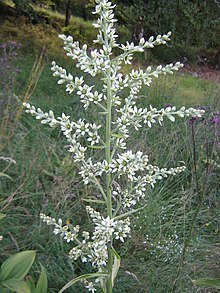Veratrum album
| Veratrum album | |
|---|---|
 |
|
| Scientific classification | |
| Kingdom: | Plantae |
| (unranked): | Angiosperms |
| (unranked): | Monocots |
| Order: | Liliales |
| Family: | Melanthiaceae |
| Genus: | Veratrum |
| Species: | V. album |
| Binomial name | |
|
Veratrum album L. |
|
Veratrum album, commonly known as false helleborine, white hellebore, European white hellebore, or white veratrum; syn. Veratrum lobelianum Bernh., is a poisonous medicinal plant of the Liliaceae (lily family) or Melanthiaceae. It is native to Europe and parts of western Asia (western Siberia, Turkey, Caucasus).
(Persian and Arabic name in traditional medicine: خربق ابیض)
The plant is a perennial herb with a stout vertical rhizome covered with remnants of old leaf sheaths. The stout, simple stems are 50 to 175 cm tall. They have been mistaken for yellow gentian, Gentiana lutea, which is used in beverages, resulting in poisoning.
Resveratrol has been isolated from the plant.
Protoveratrine is the name of an alkaloid extracted from Veratrum album that has been claimed to have use in the treatment of hypertension.
The root is very poisonous, with a paralyzing effect on the nervous system. In two cases of fatal poisoning from eating the seeds, the toxins veratridine and cevadine were present in the blood. In 1983 sneezing powders produced from the herb in West Germany were reported to have caused severe intoxications in Scandinavia.
In 2014 it was claimed that Alexander the Great could have been poisoned by a wine made from Veratrum album. Previously, it was believed that poisoning due to arsenic or the water of the river Styx (modern-day Mavroneri in Arcadia, Greece) that contained calicheamicin, a dangerous compound produced by bacteria, may have led to the death of the King of Macedon.
In antiquity, an effective emetic based on white hellebore and a bitter oval seed (which Hahneman believed was the seed of Erigeron or Senecio) was mixed by the physicians of Antikyra, a city of Phocis in Greece.
...
Wikipedia
